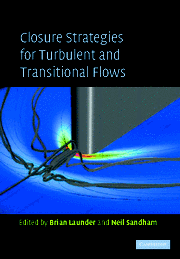4 - The Elliptic Relaxation Method
Published online by Cambridge University Press: 06 July 2010
Summary
Non-local wall effects
The elliptic nature of wall effects was recognized early in the literature on turbulence modeling (Chou 1945)and has continued to influence thoughts about how to incorporate non-local influences of boundaries (Launder et al. 1975). In the literature on closure modeling the non-local effect is often referred to as ‘pressure reflection’ or ‘pressure echo’ because it originates with the surface boundary condition imposed on the Poisson equation for the perturbation pressure, p.
The Poisson equation is (we are considering constant density flow ρ ≡ 1); the boundary condition is usually taken to be ∂p/∂xn = 0, ignoring a small viscous contribution. The boundary condition influences the pressure of the interior fluid through the solution to (1.1). Mathematically this is quite simple: the solution to the linear equation (1.1) consists of a particular part, forced by the right-hand side, and a homogeneous part, forced by the boundary condition. The fact that the boundary condition adds to the solution interior to the fluid can be described as a non-local, kinematic effect.
Figure 1 schematizes non-locality in the Poisson equation as a reflected pressure wave, but for incompressible turbulent fluctuations the wall effect is instantaneous, though non-local. Pressure reflection enhances pressure fluctuations; indeed, Manceau et al. (2001)sho w that pressure reflection can increase redistribution of Reynolds stress anisotropy. Redistribution is due to the pressure-strain correlation: the notion that it is increased by the wall effect is contrary to most second moment closure (SMC)models, which represent pressure echo as a reduction of the redistribution term.
The idea of associating inviscid wall effects with pressure reflection is natural, because the pressure enters the Reynolds stress transport equation through the velocity-pressure gradient correlation. Suppression of the normal component of pressure gradient by the wall should have an effect on the rate of redistribution of variance between those components of the Reynolds stress tensor that contain the normal velocity component – i.e., unui, where n denotes the wall-normal direction. This effect enters the evolution equation for the Reynolds stress (equation (1.3)below).
However, there is another notion about how anisotropy of the Reynolds stress tensor is altered non-locally by the presence of a wall. The inviscid boundary condition on the normal component of velocity is the no-flux condition u · n= 0. This constraint on the normal velocity produces another non-local, elliptic influence of the boundary.
- Type
- Chapter
- Information
- Closure Strategies for Turbulent and Transitional Flows , pp. 127 - 152Publisher: Cambridge University PressPrint publication year: 2002
- 3
- Cited by



